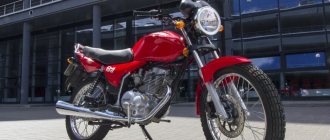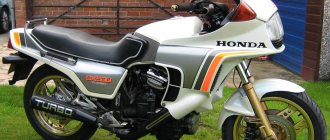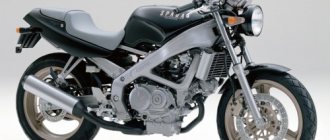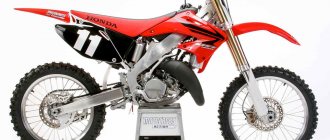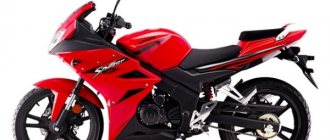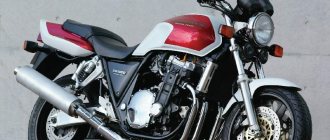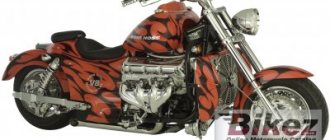Yamaha XT 600 – review of a unique motorcycle, photos and videos
For many years, one of the most popular models of the Japanese motorcycle manufacturer YAMAHA has been the XT600 model, developed back in the distant eighties of the last century. Over time, the motorcycle has evolved from a fairly highly specialized enduro into an almost absolutely universal device for traveling on and off the road. This was appreciated by both critics and fans of motorcycles by increasing the number of purchased units.
Performance characteristics of the Yamaha XT 600
Regarding the motor, it is worth noting that its original design was created back in 1975, and since then has not undergone any major changes, which, of course, has a positive effect on the reliability and ease of maintenance of the motorcycle. Although it is precisely this parameter that surprises many, because so many years have passed, new technologies and methods of their implementation have appeared, and the engine is still reliable and simple. The “heart” of the motorcycle
The power unit, developed for the famous Paris-Dakar trophy raid, was brought to almost ideal characteristics by the nineties of the twentieth century. Perhaps this is precisely the key to the genius of the developers, whose brainchild is still being used with great success.
A unique power system with two carburetors operating on different principles and responsible for different intake valves provides the engine with all the necessary mixtures for smooth and long-lasting operation in any conditions. This is a very significant plus when choosing a motorcycle in principle.
An absolute drawback of the power system is the design of the air filter, which is too susceptible to dirt and dust, which significantly reduces the service life of this important element.
The engine capacity is a very sufficient 596 cubic centimeters , which allows it to achieve a power of 42 horsepower at 6250 rpm. The engine power is more than enough to overcome both asphalt roads and very serious off-road conditions.
Chassis
Years of improvements and changes have almost completely erased serious off-road qualities from the motorcycle’s chassis. A soft suspension with small travel cannot support aggressive off-road driving that includes jumps and other motocross elements. At the same time, the motorcycle easily and at high speed overcomes difficult sections of public roads. The relative softness and low energy consumption of the suspension makes driving over long distances more comfortable. You can purchase high-quality spare parts on the pages of the online store astar.ua. The prices pleasantly surprise even experienced drivers, who know well that in our time it is quite difficult to find high-quality spare parts at an affordable price. A gas tank volume of 15 liters and an average fuel consumption of 4 - 4.5 liters per 100 kilometers provide a sufficient range for travel, while the possibility of installing tuned tanks of a larger volume brings autonomy to very respectable indicators.
In general, the age of the model has had a very positive effect on the number of various accessories that allow you to “tailor” the motorcycle for a variety of use cases.
Behavior on the road
The design of the YAMAHA XT600 quite strictly determines the environment of its use. It is very versatile, but completely unsuitable for cross-country trails. The engine's power and thrust are more than enough to overcome serious off-road conditions that do not involve jumping.
The behavior of the motorcycle on the road is extremely predictable. He forgives the pilot for mistakes that are unforgivable for others, for example, a high-speed pull to the side of the road to avoid an obstacle. At the same time, the motorcycle suspension gives the driver the opportunity not to pay attention to uneven road surfaces and the presence of stones and sand on it.
This behavior immediately puts the YAMAHA XT600 in the category of motorcycles recommended for novice pilots. Driving errors, such as the front wheel skidding during hard braking, do not lead to the expected fall.
Specifications
It is worth paying attention to the quality indicators of the Yamaha xt 600 motorcycle, as well as focusing on its strengths and weaknesses:
| Parameters (length; height) | 222; 86 cm |
| Weight | 155 kg |
| Maximum speed | 152 km/h |
| Fuel tank volume | 15 l |
| Engine | 4-stroke 1-cylinder air-cooled |
| Fuel consumption | 7.5 l/100 km |
| Engine capacity | 595.5 cu.m. cm |
| Start | Electric starter |
| Engine power | 43 l. With. at 6500 rpm |
| Brake system | Disk |
| Suspensions (front; rear) | Telescopic fork; pendulum with central shock absorber |
To begin with, it is worth noting that this model is unlikely to be able to fulfill the motorcyclist’s desire to “sit down and rush off into the distance.” Firstly, it consumes too much fuel with a not very spacious gas tank. Secondly, the equipment will have to be modified by purchasing or making cases for the necessary things.
The weight of the motorcycle is quite large (at least for the enduro class), but despite this, it is quite light and easy to control. Both Yamaha suspensions can be confidently called soft and comfortable, although they are not adjustable.
Yamaha XT660R motorcycle review
Yamaha XT660R enduro motorcycle model
appeared on the market in 2004 and is the 4th generation of the XT line (models of previous generations: XT500, XT600, XTZ660 Tenere). The model has nothing in common with previous modifications; it is equipped with a 4-valve Minarelli engine that produces 48 hp. power and 60 Nm of torque. Based on this engine, other modifications of the XT series were presented:
The main sales market for the Yamaha XT660R was Europe, but since 2005 the motorcycle has been actively sold in South America.
Among the features of the Yamaha XT660R, we should highlight a steel frame, an injector, simple suspension in the form of a conventional telescopic fork at the front and a monoshock absorber at the rear, disc brakes, a 15-liter fuel tank, a 5-speed gearbox and 181 kg of curb weight.
2016 was the last year of production of the Yamaha XT660R, after which it finally left the production line. Moreover, in the last 2 years of its life (2015 and 2021), the model was produced exclusively for the South American market.
The main competitors of the Yamaha XT660R in the class:
Content
Brief history of the model
- 2004 – start of production and sales of the model.
Model
: Yamaha XT660R (Europe and others).
Factory designation
: 5VK1, 5VK3.
- 2005 – model available in South America.
Model
: Yamaha XT660R (Europe, South America and others).
Factory designation
: 5VK4, 3S61.
- 2006 – no significant changes.
Model
: Yamaha XT660R (Europe, South America and others).
Factory designation
: 5VK6, 3S62.
- 2007 - European versions receive catalysts for the new Euro environmental standards.
Model
: Yamaha XT660R (Europe, South America and others).
Factory designation
: 5VK8, 3S63.
- 2008 – no significant changes.
Model
: Yamaha XT660R (Europe, South America and others).
Factory designation
: 5VKA, 3S64.
- 2009 – no significant changes.
Model
: Yamaha XT660R (Europe, South America and others).
Factory designation
: 5VKC, 3S65.
- 2010 – no significant changes.
Model
: Yamaha XT660R (Europe, South America and others).
Factory designation
: 5VKE, 3S66.
- 2011 – no significant changes.
Model
: Yamaha XT660R (Europe, South America and others).
Factory designation
: 5VKG.
- 2012 – the model is temporarily not produced for Europe.
Model
: Yamaha XT660R (South America).
Factory designation
: 2C1*, 2D0*.
- 2013 – no significant changes.
Model
: Yamaha XT660R (South America).
Factory designation
: 2C1*, 2D0*.
- 2014 – model again available in Europe. Last year of production for Europe.
Model
: Yamaha XT660R (Europe, South America and others).
Factory designation
: 5VKL.
- 2015 – no significant changes.
Model
: Yamaha XT660R (South America).
Factory designation
: 2C1*, 2D0*.
- 2016 – no significant changes.
Model
: Yamaha XT660R (South America).
Factory designation
: 2C1*.
Photos
Specifications
Yamaha XT660R Specifications:
| Model | Yamaha XT660R |
| Motorcycle type | enduro |
| Year of issue | 2004-2016 |
| Frame | steel |
| engine's type | 1-cylinder, 4-stroke |
| Working volume | 660 cm³ |
| Bore/Stroke | 100.0 x 84.0 mm |
| Compression ratio | 10.0:1 |
| Cooling | liquid |
| Number of valves per cylinder | SOHC, 4 valves |
| Fuel supply system | injector, 1x Mikuni 44 mm |
| Ignition type | digital TCI |
| Maximum power | 48.0 hp (35.3 kW) at 6000 rpm |
| Maximum torque | 60.0 Nm (6.1 kg-m) at 5250 rpm |
| Clutch | Multi-disc in oil bath, cable drive |
| Transmission | 5-speed |
| type of drive | chain |
| Front tire size | 90/90-21 M/C (54S) |
| Rear tire size | 130/80-17 M/C (65S) |
| Front brakes | 1 disc, 298 mm, 2-piston caliper |
| Rear brakes | 1 disc, 245 mm, 1-piston caliper |
| Front suspension | 43 mm telescopic fork, travel – 225 mm |
| Rear suspension | pendulum with monoshock absorber (preload adjustment), stroke – 200 mm |
| Motorcycle length | 2240 mm |
| Motorcycle width | 845 mm |
| Motorcycle height | 1230 mm |
| Wheelbase | 1505 mm |
| Seat height | 865 mm |
| Minimum ground clearance (clearance) | 210 mm |
| Acceleration to 100 km/h | 5.3 sec |
| Maximum speed | 160 km/h |
| Gas tank capacity | 15.0 l (including reserve - 5.0 l) |
| Motorcycle weight (curb) | 181 kg |
Fuel consumption
Average fuel consumption on the Yamaha XT660R, according to test results, is approximately 4.9 liters per 100 km. The exact value depends on the riding style and surface of travel.
Video
The price for a used Yamaha XT660R model starts from 200,000 rubles.
Reviews
Yamaha XT660R reviews:
A freaky, fun and daring motorcycle. Somewhat reminiscent of a cheerful one-year-old puppy running out for a walk. Even if his thrust is far from the same as, say, Bandit 1200. He rushes like an African buffalo. But there is no such fun in it, it is a heavy and serious waste. After these rides, I still ran in 600 kilometers and seemed to get a feel for my motorcycle. I got used to driving at low speed with almost constant crankshaft speed. As a result, I didn’t bother to eliminate the interruptions at low speeds, I’m too lazy and don’t bother me. The reason is clear and does not cause concern. As for oil consumption, I haven’t noticed it yet, although the previous owner says he topped it up sometimes. And it became clear to me why for several years I could not find a motorcycle for my soul. It's not just about your tasks. The main thing, it seems, is the similarity of temperaments. The moto's must be the same as the motorcyclist's. The XT660R has a temperament similar to mine - choleric. That's why it's a thrill. Let it be for now. And then we'll see.
Of course, the cross-country ability of this motorcycle is far from Dzhebelovskaya. You can ride it wherever it goes. A motorcycle for dry roads or dry off-road. You can feel the weight, and it skids much more than Jebel when cornering. You can’t really carry 172 kg on yourself. dry weight. I once went downhill on the DR250. I was able to climb onto the road only after I had removed all the weight. I had to drag the motor along. The wheels didn't move on the sand. I couldn't get the XT660R out of there without a winch. It stands on the road like a glove, but still not like a real road worker. There seem to be enough brakes, but it wouldn’t hurt to add more in front. This motorcycle is suitable for travel within a radius of 200 - 300 km. from home, when you can drive along the highway without thinking about fatigue. Or for a long-distance journey, to drive at a speed of 90 km/h.
Motorcycles in this series, XT660R and XT660Z Tenere, differ in tank volume (15 and 22 liters, respectively), suspension travel (225 and 210), fork angle, weight (172 and 183) kg, ground clearance (210 and 245), and slightly in saddle height and a little - in size. The XT660Z Tenere has two front brake discs. Both motorcycles are used over the hill for long trips, including around the world. Many people don't like the XT660R, but those who do like it really like it. I am among them. I do not advise you to take this mot based on any descriptions. He is very unique. You should definitely go for a ride. And even then, as in my case, an opinion does not form immediately.
The XT660R and XT660Z Tenere motorcycles have the same Minarelli engine, which is considered very reliable. The engine is produced in Bologna, the engine as a whole is produced in France. Minarelli engines are installed on: Yamaha: Booster 50, X-Max 250, XT660; Malaguti: Phantom 50, Password 250; Aprilia: Pegaso 660 and others, including the Yamaha Raptor 700 ATV. The camshaft is on rolling bearings, like the crankshaft. The gaps on the fists are adjusted with screws. It is impossible to buy spare parts in Japan due to sky-high prices. Ebay is full of used and new ear units and parts at reasonable prices. The main source of tuning and spare parts are stores in the UK and Germany. This motorcycle was not delivered to the States; it is not included in the list of motorcycles on American websites. Although the Americans collected signatures from Yamaha in their country with a request to organize the supply of XT660 motors to their country.
So it turned out that I was going to choose from 5 models, and settled on the second one. Perhaps the XR650L would be to my taste as well as other motorcycles; judging by the reviews, I did not find any shortcomings in it (those that I did find suit me). Most likely this would be the case. So far I haven't come across any bad motorcycles at all.
Hi all. There are a lot of letters because we have very little information on this motorcycle. It will be useful for someone, and our forum is gradually turning into a general forum, which is very good. And now I’m selling Jebel, although without haste. I won’t sell it, I won’t be upset, there will always be a place for it. Great bike.
My first ENDURO grip
I traveled 200 km off-road on this particular motorcycle. My data is 175cm/80kg.
In a nutshell: the more SOLID soils and asphalt, the more preferable and correct this choice.
The engine is eternal, but you need to keep an eye on the oil. There are no jambs in the design of the engine. There is no low end, but locomotive traction from 3000 rpm all the way to the end of the handle. For example, my IksAr-650 is walking next to me with a tachometer of 1000-1400 rpm at a speed of 4-5 km/h. Potentially, the XT660Er cannot afford this, but it is STILL not necessary on asphalt and hard soils. THERE you need the courage to turn the knob and then the potential of this engine is revealed at 100%. Comfortable to fit. But it won't be comfortable without glass.
This season I bought an XT660R. I’ve already traveled to Brest (I got there in 11 hours), and I’ve been drinking for about 400 km. There is a windshield. Cruising confident 120-140. Then it starts to shake. The moto, unlike the 600E, is more adapted for roads. Better brakes, more powerful suspension, lights, more explosive engine. Allows you to easily overtake after 110, at 600E this is problematic. Better to steer. There is an emergency warning light button, a gasoline sensor (+ when the gasoline light turns on, the km countdown begins in reserve). Unlike the 600E, there is no tachometer.
The motor is much more dynamic.
660R is 30 kg heavier. There is no bass on it, maybe you can reconfigure the injector, but I don’t know. You have to drive it off-road; it doesn’t run at low revs.
It is not popular in Russia and therefore the price is quite low. But it is incredibly popular in Europe. Tuning (4 types of biggrin running boards alone) and a sea of spare parts. There are a bunch of sites dedicated specifically to the XT660R/X.
Last year I bought an XT660R, this is the second season. The car is extremely reliable, perfectly balanced, super design. The dynamics of acceleration in the city are simply a whirlwind; at high speeds it’s scary beyond 130 km. I wanted the F650GS at first, but the XT is more creative. In the city, traffic jams are not a problem, handling is confident. Next season I'm going to test it with a long-distance shot. Good luck.
Advantages and disadvantages
Based on reviews from Yamaha xt 600 owners, the motorcycle has an impressive list of advantages, including:
- Reliability.
- Low cost.
- Long lasting engine.
- Durable plastic casing.
- Flawless suspension and braking system.
- Comfortable seating position (even for drivers whose height does not exceed 170 cm).
The disadvantages of the motorcycle are the following:
- A weak frame.
- Air filter not suitable for off-road driving.
- Poor engine protection.
- The appearance of dents and scratches on the gas tank due to the slightest drop or other damage.
- The gas tank is small and unsuitable for long rides.
- Lighting devices do not always cope with their responsibilities.
In addition, some motorcyclists believe that the speed (maximum and cruising) of this model is low (155 and 140, respectively), and the rear brakes are not very effective.
In conclusion, it is worth saying that this motorcycle is quite suitable as a first equipment, precisely because of its positive qualities. Sitting on it, you are unlikely to feel 600 cubic meters and 43 hp. With.
Yamaha XT660X
text from MotoDrive No. 11, 2006
At times we have to complain that the majority of people still live with some kind of illusions about what is best to ride in the open spaces of their fatherland and do not want to understand that enduro is a panacea. I thought so, I thought, but when it came to testing the Yamaha XT660X motard, the brother of the XTR enduro, which we tested in the seventh issue of Moto-Drive this year, it turned out that these cars leave showrooms faster than fresh ones pies from the bakery on the weekend. Nevertheless, those who seek will always find!
For the test we got a bright orange “Japanese” with a distinctly combative look. Although... is he Japanese? Paioli telescopic forks, Brembo brakes, Excel wheels and Pirelli tires give food for thought about the assimilative properties of the Italian climate.
The design of the bike exactly repeats its enduronic “relative”: the plastic body kit is made in the style of the WR series hard machines and looks very interesting. Having exchanged untrodden paths for a mirror of asphalt (quite chipped in places), the Yamaha XT660X lost 21-inch front and 17-inch rear wheels with “toothy” universal tires. Their place was taken by Italian seventeen-inch Excel spoked wheels and the most road-ready Pirelli tires. The handling requirements of a motard are somewhat different from those of an enduro, so on the XTX the fork angle is 1.25 degrees less and is 26 degrees. Accordingly, the front wheel offset is also smaller, equal to 94 mm (107 for the enduro modification). The next significant difference is in the suspension settings. They use more rigid elements, and the front fork travel is reduced to 200 mm. The travel of the rear pendulum suspension remains the same and is also 200 mm. The engine is one of two modifications and does not bear any differences. The single-cylinder liquid-cooled dry-sump power unit is equipped with a four-valve head with a single camshaft. However, 48 horsepower on the XTR and 48 horsepower on the XTX are not the same. For some reason, the Japanese engineers’ motard turned out to be five kilograms heavier than the enduro (and the dry weight of about 177 kg is not small in itself), so if there were more “horses”, no one would be offended. Large “banks” of mufflers, located in the “tail” of the bike, give the motorcycle solidity, and also carry an integral attribute of modernity - a catalytic converter. Thanks to this device, as well as the electronic fuel injection system, it was possible to fit into Euro 2 environmental standards and, my heart feels, the arrival of Euro 3 will be met without any problems. The considerable dry weight of the motorcycle becomes noticeable when maneuvering in dense traffic at low speed, it is annoying and encourages you to quickly break into the “operational space”. In order to ride this motorcycle like a real street fighter should, you will have to take care of proper physical shape, otherwise David will not defeat Goliath. If you don’t want to be “fast”, then the bike will help with its juicy torque characteristics (60 Nm are produced at just 5250 rpm), but you should remember that large-volume single-barrels don’t like ultra-low speeds and begin to “choke,” which is expressed in convulsive jerks.
Meanwhile, when the flow of cars thins out a little and picks up speed, you begin to understand what the fundamental difference is between the two cars in the series. The Yamaha XT660X stands rooted to the road - the combination of a fairly large stroke with tight settings gives reliable contact with the road surface. Maneuvering, changing lanes, and cornering are easy; there is not the slightest hint of the “coldness” noted by our testers in the behavior of the enduro. The broken exits from the bridge, which used to be passed almost on foot, no longer attract attention. Little by little, a sweet feeling of permissiveness begins to awaken, the XT naturally pampers the driver. Despite the fact that high speeds are not the “calling” of such machines, the Yamaha XT660X gives no reason to complain about its behavior even at speeds of 140-160 km/h (enduro did not like such modes at all). A natural limiter to the heat is the lack of a normal fairing, so those who like to travel at cruising speed will most likely have to think about installing a tuning windshield. Seventeen-inch Pirelli tires grip the asphalt tenaciously, and when it seems that it’s dangerous to lay the bike down further, it turns out that you still have a solid reserve, and the illusion of danger is the result of a high landing. The ergonomics of the driver's seat are good. The long “bench seat” is pleasantly firm, just enough so that the driver does not relax and “does not go out of character.” The straight, wide handlebars and low-mounted footpegs ensure an assembled and at the same time comfortable riding position. You can stand up on the footrests with equal ease, move towards the tank when braking and accelerating, hang out in a turn or move cross-country to the outer part of the seat. The choice of style depends on the driver, but the bike offers all the conditions for realizing ambitions. The rear-view mirrors provide a passable overview, the quality of which drops sharply if you rev the engine hard: at high speeds, the 660 cc single-barrel engine works roughly, creating noticeable vibrations. Brembo brakes help calm the driver's ardor. Like the enduro, the XTX has a single-disc brake, but its diameter is a respectable 320 millimeters, and is paired with a four-piston caliper instead of a two-piston one. At the rear there is a 220 mm brake with a two-piston caliper. The brakes are good, the bike stops dead in its tracks. At the same time, we are pleased with the clear feedback provided by the reinforced front brake hose, which is already installed “in the base”. Stopping on the Yamaha XT660X is much easier than it might seem when looking at the massive silhouette of the motorcycle. The instrument panel is ascetic, but you don’t have to look there too often, except to inquire about the remaining fuel in the tank. But no one will provide you with exactly this information; only when the reserve is turned on, a warning light will appear, which is not very convenient.
The Yamaha XT660X is a great fan machine for the city. If we were talking about supermotards in their pure, canonical form, then it would be more appropriate to test the Yamaha WR with a “whale” of road wheels. It would be a bomb. But Japanese designers decided to go “from the other side” and offered a universal city motorcycle. It does not provoke recklessness, does not make the blood boil or the heart beat faster. The XTX simply significantly expands the boundaries of what is allowed in our road reality, but still its weight is too large. In essence, the XTR is more of an enduro than the XTX is a motard. If you throw away the canons and look outside, then he won’t have many rivals (you can count them on the fingers of one hand). A pleasant engine, brakes with clear feedback and high efficiency, comfortable landing, the ability to go really fast, regardless of the quality of the asphalt. These are the cornerstones on which the philosophy of such machines in general and the Yamaha XT660X in particular is based. If desired, nothing prevents you from installing a higher glass and mount for panniers, and here in front of you is almost a touring motorcycle, which will definitely not allow you to approach a mountain stream hidden in a secluded impassable corner, but will make you a king on serpentine roads. Its exterior, design features and internal essence allow us to compare the bike with alternative directions in music. This is something between pop music and rock, but with notes of urbanism. The price of versatility in Ukraine is 55,162 UAH, which is a justified investment, but provided that you clearly understand why such bikes exist.
Text: Denis Los Photo: michel
EICMA-2008: New colors for Yamaha XT660X
Japanese Yamaha Motor presented a new color scheme for the XT660X motorcycle at the EICMA 2008 exhibition in Milan.
Offering one of the best combinations of on-road and off-road performance on the market, this bike is available for 2009 in three colors - Racing Blue, Yamaha Black and White Sports.
XT660X - a device with technology inherited from supermotards, has a power unit in the form of a single-cylinder engine with electronic injection with a power of 48 hp. (at 6,000 rpm). Maximum torque – 60 Nm (at 5,250 rpm).
Featuring a compact steel frame, 17-inch wheels, Brembo brakes, aggressive styling and a wide range of optional accessories, the 2009 Yamaha XT660X is redesigned.
EICMA is the largest motorcycle exhibition in the world. This year it takes place for the 66th time. Last year, in 2007, 1,937 brands (1,515 motorcycles and 452 bicycles) from 39 countries were represented here. During all the days of operation, the salon was visited by 535,000 people.
Engine
The carbureted 600cc inline-4 engine produces a ton of torque and is particularly lively from mid-range and above. Thanks to the Viper exhaust, the motorcycle has a delicious sound. The torque is distributed linearly, but not boringly, the bike provokes you to twist harder when exiting each turn.
Is it worth buying?
This particular bike is great proof that live examples of the Yamaha Thundercat can still be purchased today. Everything works as it should, and the aftermarket modifications improve an already great bike. If you are ready for the fact that it is not new and bears traces of past years, then why not? This is a very versatile motorcycle, suitable for long trips, Sunday rides, and everyday city riding.
